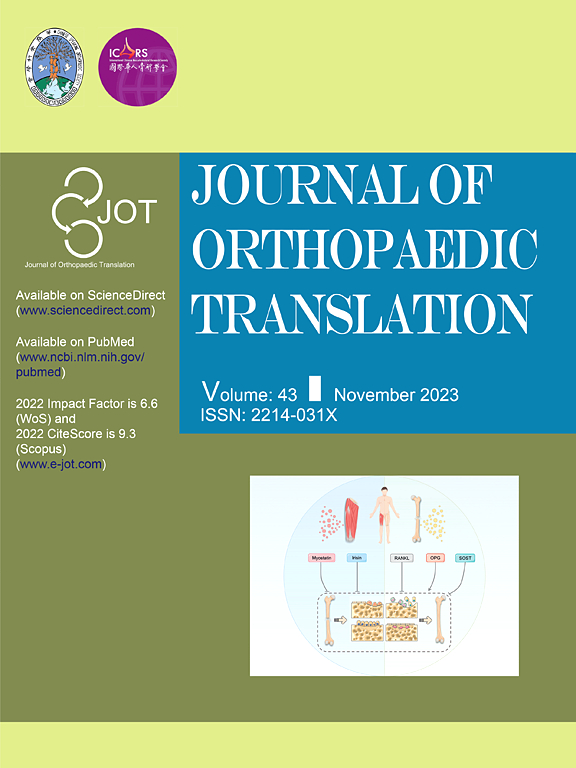线粒体保护剂 SS31 优化了脱细胞沃顿果冻支架,可改善异体软骨细胞植入介导的关节软骨修复效果
IF 5.9
1区 医学
Q1 ORTHOPEDICS
引用次数: 0
摘要
异体软骨细胞植入的过程需要获得供体软骨细胞,在富含生长因子的培养基中培养,然后将它们单独或与生物相容性支架一起引入软骨损伤区域。虽然有希望,但这种方法受到植入软骨细胞线粒体功能障碍的阻碍。方法从人脐带中提取去细胞脐带沃顿氏胶(DUCWJ),制备新型支架。支架的制造过程包括脱细胞和冻干。所得到的支架具有优异的特性,包括高孔隙率、亲水性和良好的生物相容性。为了增强其功能,以线粒体保护特性而闻名的SS31肽被化学结合到支架表面,创建了一个SS31@DUCWJ系统。该系统旨在保护软骨细胞,调节线粒体呼吸链(MRC),从而改善同种异体软骨细胞植入介导的软骨修复。结果体外研究表明,SS31可有效减轻连续传代引起的代谢功能障碍、细胞外基质降解、氧化应激、炎症和线粒体损伤。补充体内实验表明SS31@DUCWJ支架可促进兔股骨髁缺损健康关节软骨的再生。结论ss31修饰的多孔脱细胞支架是一种具有抗炎特性和靶向线粒体调控的创新生物材料。它为治疗关节软骨损伤提供了一种有希望的新方法。我们的研究首次成功地将线粒体保护剂SS31装载到DUCWJ水凝胶支架上,用于局部给药。该方法在修复软骨缺损方面非常有效,为此类疾病的治疗提供了一条有希望的新途径。本文章由计算机程序翻译,如有差异,请以英文原文为准。

The mitochondrial protectant SS31 optimized decellularized Wharton's jelly scaffold improves allogeneic chondrocyte implantation-mediated articular cartilage repair
Background
The process of allogeneic chondrocyte implantation entails obtaining donor chondrocytes, culturing them in a medium enriched with growth factors, and then introducing them-either individually or in conjunction with biocompatible scaffolds-into areas of cartilage damage. While promising, this approach is hindered by mitochondrial dysfunction in the implanted chondrocytes.
Methods
This research introduced an innovative approach by creating a new type of scaffold derived from Decellularized Umbilical Cord Wharton's Jelly (DUCWJ) extracted from human umbilical cords. The scaffold was manufactured using procedures involving decellularization and lyophilization. The resulting scaffold demonstrated superior characteristics, including high porosity, hydrophilic properties, and excellent biocompatibility. To enhance its function, SS31 peptides, known for their mitochondrial-protective properties, were chemically bonded to the scaffold surface, creating an SS31@DUCWJ system. This system aims to protect chondrocytes and regulate the mitochondrial respiratory chain (MRC), thereby improving cartilage repair mediated by allogeneic chondrocyte implantation.
Results
In vitro studies have shown that SS31 effectively attenuates metabolic dysfunction, extracellular matrix degradation, oxidative stress, inflammation, and mitochondrial damage induced by serial cell passages. Complementary in vivo experiments showed that the SS31@DUCWJ scaffold promoted regeneration of healthy articular cartilage in femoral condylar defects in rabbits.
Conclusions
This SS31-modified porous decellularized scaffold represents an innovative biomaterial with anti-inflammatory properties and targeted mitochondrial regulation. It offers a promising new approach for treating articular cartilage injuries.
The translational potential of this article
Our study was the first to successfully load the mitochondrial protectant SS31 onto a DUCWJ hydrogel scaffold for localized drug delivery. This method is highly efficacious in repairing cartilage defects and offers a promising new avenue for the treatment of such conditions.
求助全文
通过发布文献求助,成功后即可免费获取论文全文。
去求助
来源期刊

Journal of Orthopaedic Translation
Medicine-Orthopedics and Sports Medicine
CiteScore
11.80
自引率
13.60%
发文量
91
审稿时长
29 days
期刊介绍:
The Journal of Orthopaedic Translation (JOT) is the official peer-reviewed, open access journal of the Chinese Speaking Orthopaedic Society (CSOS) and the International Chinese Musculoskeletal Research Society (ICMRS). It is published quarterly, in January, April, July and October, by Elsevier.
 求助内容:
求助内容: 应助结果提醒方式:
应助结果提醒方式:


